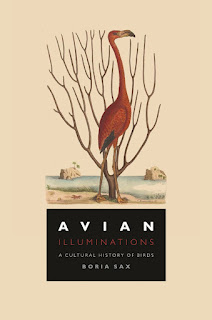
Sax applied the “Page 99 Test” to his new book, Avian Illuminations: A Cultural History of Birds, and reported the following:
At the top of page 99 of Avian Illuminations is a picture in color of a young Arctic tern engaged in its epic migration between Antarctica, where it spends winters, and Iceland, where it breeds. The bird, entirely white except for a dark area on its head and an orange beak. The sunlight flashes from the edges of its extended wings, which stand out against the dark, undulating waves below. The viewer will probably linger on the picture a short while before reading the text.Follow Boria Sax on Twitter.
That begins in the middle of a sentence: “...to ‘The free, wild winds, and the songs of the birds’, he remembers his childhood home.” Who remembers? No, it is not just the bird. Even without the previous page, it is probably not hard to guess that this is from a maritime ballad. The book goes on to tell how sailors observed birds for many purposes from ascertaining the distance of their ship from land to predicting weather and even relieving the loneliness of the sea. In folklore, people have thought that gulls and many other birds were souls of drowned mariners.
Then, at the bottom of the page, comes a subtitle: “Migration or Hibernation?”: “People have always been amazed at the precision with which birds arrive at fixed times of the year, which was so reliable that people could tell the time....” That’s all there is, at least if one doesn’t turn the page.
Were somebody to spot this book in a library, open it at random, and find this page, these would be fragments. She would put them together in a personal way. He might identify with the Artic tern. She might identify with the loneliness of sailors. He might think about vacations, sleep, schedules, or many other things. The book becomes less of an exposition and more of a poem, but the major themes at least are much the same.
But the reader may do these things anyhow in time. She may read the book cover to cover, and look at every picture, but will probably remember images, whether visual or mental, better than complicated arguments. He will then rearrange these at least a bit, like a bird rebuilding a nest after a migratory journey. I’d say the test works pretty well.
--Marshal Zeringue



